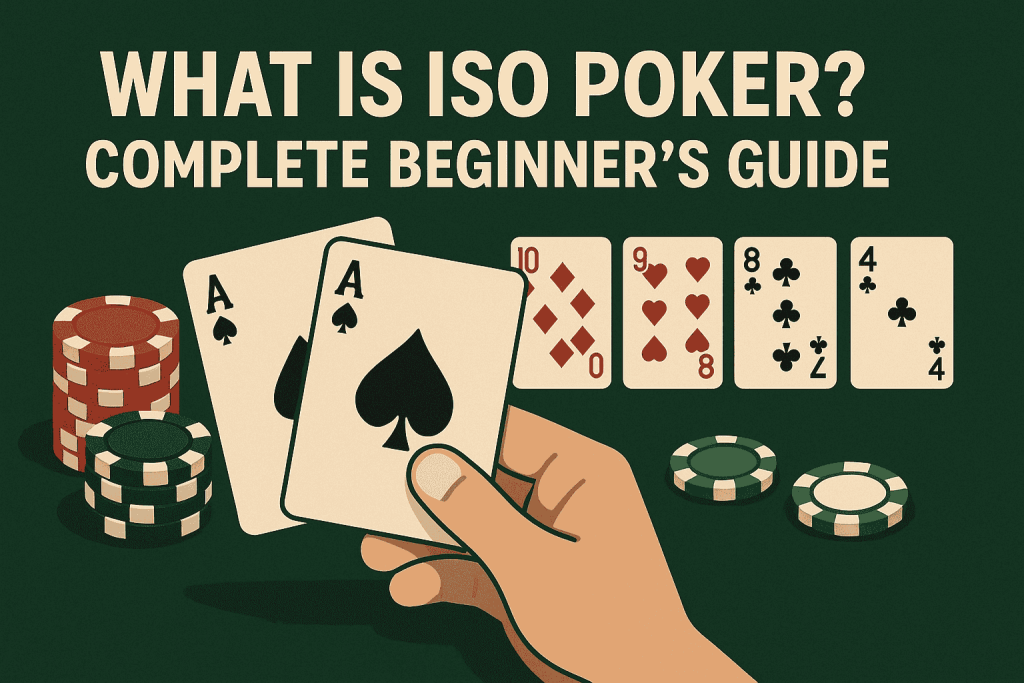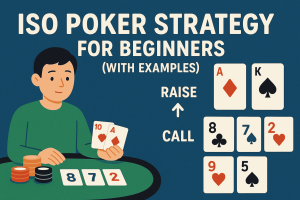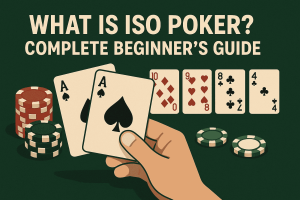If you’re new to the world of poker, you may have already encountered terms that seem unfamiliar or technical. One such term is “ISO” or “isolation raise.” Understanding the iso poker meaning is crucial if you want to grasp the strategic layers of poker, especially in games like No-Limit Texas Hold’em.
The term “ISO” is an abbreviation of “isolation” and refers to a specific kind of pre-flop raise. The purpose of an ISO raise is to isolate a particular player — usually a weaker one — and play the hand heads-up against them. By doing this, you attempt to take control of the hand and capitalize on the positional or skill-based advantage.
What Does ISO Mean in Poker?
To answer the question “what does ISO mean in poker?” in simple terms, it means making a raise after another player has limped into the pot. Limping means a player has just called the big blind instead of raising. This is usually seen as a passive play, often associated with inexperienced or recreational players. An ISO raise targets these limpers to remove other players from the hand and isolate the limper.
For example, in a $1/$2 ISO Poker cash game, if an early-position player limps in for $2 and you are in the cutoff with a decent hand like Ace-Queen, you might raise to $10. This raise is considered an ISO raise, aimed at getting heads-up against the limper rather than inviting multiple players into the pot.
Why Is ISO Raising Important in Poker Strategy?
The ISO poker term is not just jargon; it reflects a foundational tactic used by skilled players. ISO raising allows you to manipulate the table dynamics and gain control over a hand right from the start. There are several strategic benefits to executing an ISO raise effectively.
First, you narrow down the field. Poker becomes much easier to manage when you are heads-up instead of facing multiple opponents. Second, ISO raises often force limpers — who may be playing speculative or weak hands — to fold or call out of position. Finally, you can apply pressure post-flop, using your position and initiative to make continuation bets or even bluff effectively.
Recognizing Good ISO Spots
Not every limp is an opportunity for an ISO raise. The success of this strategy depends on several factors, including your position at the table, the tendencies of the limper, your hand strength, and stack sizes.
The best iso poker scenarios occur when you’re in a later position and the limper is a predictable, weak player. These players are less likely to re-raise or play aggressively post-flop. If you have a reasonably strong hand and enough chips to put pressure on your opponent, you are in a good spot to execute an isolation raise.
However, ISO raising a solid or tricky opponent might backfire. Experienced players may limp with premium hands or try to trap you. That’s why it’s essential to profile your opponents and adapt your strategy based on their tendencies.
How to Execute an ISO Raise
The mechanics of an ISO raise are straightforward. After a limp, you raise to an amount that ideally eliminates other players and forces the limper to make a decision. The size of the raise should be larger than a typical open-raise, since you need to discourage overcalls from the blinds or other limpers.
A good guideline is to raise 3x the limp amount, plus an extra amount for each additional limper. For example, if one player limps for $2, and you’re in position, a raise to $8-$10 usually gets the job done. If there are multiple limpers, increase the size accordingly.
Stack size also plays a crucial role. Deep stacks give you more room to maneuver post-flop, while shorter stacks limit your options. Always consider your own stack as well as your opponent’s before committing to an ISO raise.
Common Mistakes with ISO Raising
Many new players misuse the iso poker term in practice because they either ISO too frequently or in the wrong situations. Here are some frequent mistakes to avoid:
One major error is attempting to isolate when out of position. Being out of position makes post-flop play harder and reduces the effectiveness of your isolation. Another mistake is trying to ISO with marginal hands against tight or tricky players who limp strong. This often results in you playing a weak hand against a strong range, which can be a costly error.
Some players also ignore stack sizes. Trying to ISO a short-stacked player may turn your raise into a shove-or-fold decision for them, which could force you into uncomfortable all-ins. A thoughtful approach to sizing and timing helps avoid these issues.
Advanced ISO Poker Strategies
Once you’re comfortable with the basic iso poker meaning and mechanics, you can start integrating more advanced concepts into your game. For example, ISO raising doesn’t always have to be done with premium hands. You can use it as a bluffing tactic, especially against players who fold too often to raises.
Also, mixing up your range is important. If you always ISO with big hands, observant opponents will adjust. Including suited connectors, small pairs, or even speculative hands in certain situations can keep your strategy balanced and unpredictable.
Using software or tracking tools can also help identify profitable ISO spots in your game. Reviewing hands and analyzing opponent tendencies allows you to fine-tune your approach over time.
ISO Poker in Tournaments vs Cash Games
The effectiveness of ISO raises can vary depending on whether you’re playing a tournament or a cash game. In tournaments, stack sizes fluctuate more frequently, and blinds increase, affecting the dynamics of isolation plays.
In early tournament stages, players are deeper stacked, and ISO raising works similarly to cash games. However, as the tournament progresses and stacks get shorter, ISO raises often turn into shove-or-fold spots. You must adjust your range and be mindful of ICM (Independent Chip Model) implications when isolating short stacks late in a tournament.
In cash games, you can ISO more freely due to deeper stacks and fixed blinds. There’s more post-flop play, so positional awareness and opponent profiling become even more important.
When Not to ISO
Despite its value, ISO poker is not a one-size-fits-all solution. There are times when choosing not to ISO is the better strategic decision. For example, if you are holding a speculative hand and facing a limp from an aggressive opponent who might re-raise, it may be better to just call or even fold.
Additionally, if your table is highly active and players frequently defend their blinds or 3-bet light, ISO raising becomes riskier. Knowing when to fold or flat-call instead of isolating is a skill in itself and reflects a deeper understanding of game dynamics.
Conclusion: Mastering the ISO Poker Term for Strategic Advantage
Understanding the iso poker term is more than just learning a piece of jargon. It represents a tactical approach that gives you control over hands and positions you to take advantage of weaker opponents. By applying the right timing, sizing, and opponent analysis, you can use ISO raising to elevate your game significantly.
Whether you’re grinding online tournaments or sitting at a live cash game table, the isolation raise should be a vital part of your pre-flop arsenal. Over time, with practice and awareness, your ability to isolate and exploit limpers will become second nature — and so will your edge over the competition.
To deepen your knowledge of poker strategy, you can check out this comprehensive poker guide at Upswing Poker.




